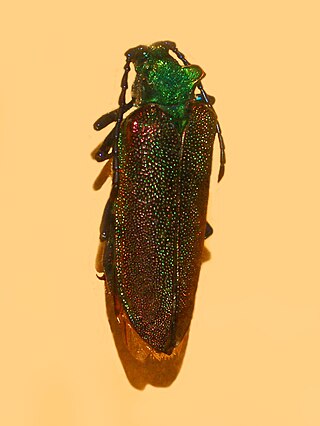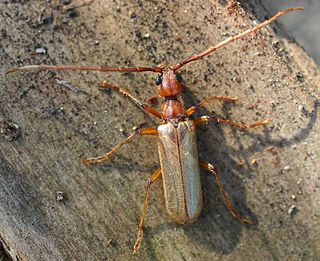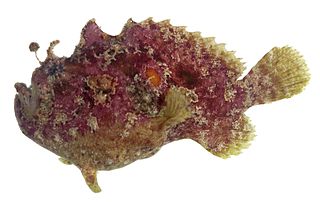
The Oxypeltidae are a small family belonging to the superfamily Chrysomeloidea, widespread in the Andean region of Chile and Argentina. They have traditionally been considered a group within the Cerambycidae.

The Vesperidae are a small family of beetles, normally classified within the family Cerambycidae, of heterogeneous aspect but all characterised by larval stages related to roots of herbaceous plants or trees
Kachinus is an extinct genus of ant-like stone beetle in the family Staphylinidae containing the single species Kachinus antennatus.
Cimex antennatus is a species of Cimicidae endemic to North America. Its primary hosts are bats.
Microschismus antennatus is a species of moth of the family Alucitidae. It was described by Thomas Bainbrigge Fletcher in 1909 and is known from South Africa.

Antennatus is a genus of marine ray-finned fishes belonging to the family Antennariidae, the frogfishes. The fishes in this genus are found the Indian and Pacific Oceans.

Chilomycterus antennatus, the bridled burrfish, is a species of fish belonging to the family Diodontidae. It is native to the tropical waters of the Western Atlantic from southeastern Florida and the Bahamas to northern South America. They are also found in the Eastern Atlantic off the cost of Mauritania.

Cantharocnemis antennatus is a species of longhorn beetles of the subfamily Prioninae.
Lochmodocerus antennatus is a species of beetle in the family Cerambycidae, and the only species in the genus Lochmodocerus. It was described by Burne in 1984.
Pseudomacrochenus is a genus of longhorn beetles in the subfamily Lamiinae, containing the following species:
Pseudomacrochenus affinis is a species of beetle in the family Cerambycidae. It was described by Stephan von Breuning in 1960. It is known from India.

Pseudomacrochenus wusuae is a species of beetle in the family Cerambycidae. They are found in Sichuan, China.
Agabus antennatus is a species of predaceous diving beetle in the family Dytiscidae. It is found in North America.
Phloeosinus antennatus is a species of crenulate bark beetle in the family Curculionidae. It is found in North America.

Abantennarius coccineus, the scarlet or freckled frogfish, is a species of frogfish originally classified as Chironectes coccineus and Antennarius coccineus. It lives within tropical waters and has a central distribution being around Indo-East-Pacific areas- excluding Hawaii. The habitat of the scarlet frogfish is in the shallow zones of the ocean. It is found within reef areas, in rocky mounds or sponges where there are places for it to hide amongst from predators. The scarlet frogfish comes in a variety of colours, from tan and brown colours to bright reds and yellows and will grow to a maximum length of 13 centimetres (5.1 in). It can be identified taxonomically through its pectoral rays, the presence of dark patches that appear on its fins and body, along with its lack of distinctive tail base. The scarlet frogfish is not harmful to humans and is not caught by fisheries for consumption purposes, however it has been caught previously for studies relating to the abundance of reef-dwelling fish and as bycatch of shrimp trawling. Similar to other frogfish species, the scarlet frogfish is a predatory carnivore and exhibits a low degree of sociality, only interacting with other scarlet frogfish during their mating period.

Chthamalus antennatus, the six-plated barnacle is a species of intertidal barnacle found in eastern and southern Australia. Growing from two centimetres wide and one centimetre high. The barnacle is found on the coast, usually on rocks at or above the high tide level or just below the splash zone. Feeding occurs only at unusually high tides.
Antennatus flagellatus, sometimes known as the whip frogfish, is a species of fish in the family Antennariidae. It is known only from Kashiwajima Island, Kōchi, Japan, and it was described from two specimens collected from a rock ledge on a sandy slope near the island. It occurs at depths of less than 45 m (148 ft) and reaches 4.9 cm SL. This species can be distinguished from other members of the genus Antennatus by its notably long illicium, which can exceed 40% of the fish's standard length.
Antennatus linearis, sometimes known as the pygmy anglerfish or the lined frogfish, is a species of fish in the family Antennariidae. It is native to the Indo-Pacific, where it is known from East Africa, the Aldabra Islands, the Comoro Islands, the Molucca Islands, and the Hawaiian Islands. It is a secretive reef-dwelling fish that occurs at a depth of 4 to 33 m and reaches 7.5 cm SL. This species is usually seen under coral rubble or in rocky areas. It is the most recently described species in the genus Antennatus, as well as the only species in the genus described in the 21st century.
Antennatus strigatus, the bandtail frogfish, is a species of marine ray-finned fish belonging to the family Antennariidae, the frog fishes. This species is found in the eastern Pacific Ocean.

Antennatus tuberosus, the tuberculate anglerfish, pygmy angler, pygmy frogfish or tuberculated frogfish, is a species of marine ray-finned fish belonging to the family Antennariidae, the frogfishes. This fish is found in the Indian and Pacific Oceans.








